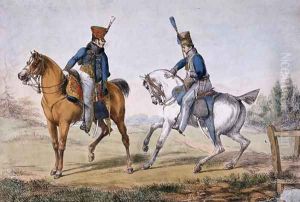Hull, Edward Paintings
Edward Hull was an English artist known for his contributions to the Victorian art scene, particularly within the medium of ceramics and glass painting, as well as his work as an illustrator. Born in 1829, Hull's artistic journey began at a young age, influenced by the burgeoning arts movement of the 19th century in England. His work is characterized by a meticulous attention to detail and a passion for exploring the interplay of color and light, which is particularly evident in his ceramic designs and glass artworks.
Educated in the arts from a young age, Hull quickly established himself within the artistic communities of England. He became especially noted for his work with Minton, a renowned ceramics manufacturer, where he contributed to the development of their majolica and porcelain pieces. His designs often featured intricate patterns and were inspired by the natural world, a common theme in Victorian art. Hull's work in ceramics was highly regarded for its innovation and craftsmanship, earning him recognition and accolades during his lifetime.
In addition to his ceramic works, Hull was also a talented illustrator. He contributed illustrations to various publications, showcasing his versatility as an artist. His illustrations often featured scenes from nature, aligning with the Victorian era's fascination with the natural world. Hull's ability to capture the intricacies of his subjects made his illustrations highly sought after by publishers and the public alike.
Hull's contributions to the art world extended beyond his work with ceramics and illustrations. He was involved in the design and decoration of glass, an area where his talents in color and light were particularly well-suited. His glass artworks are noted for their beauty and technical skill, contributing to the period's larger stained glass revival.
Edward Hull's career spanned several decades of the Victorian era, a time of great change and innovation in the arts. His work reflects the era's values and aesthetics, capturing the beauty of the natural world and the intricacies of design that defined the period. Hull passed away in 1906, leaving behind a legacy of artistic achievement that continues to be appreciated for its contribution to the decorative arts. His work remains a testament to the creativity and skill of Victorian artists, and his influence can still be seen in the fields of ceramics, glass art, and illustration.
